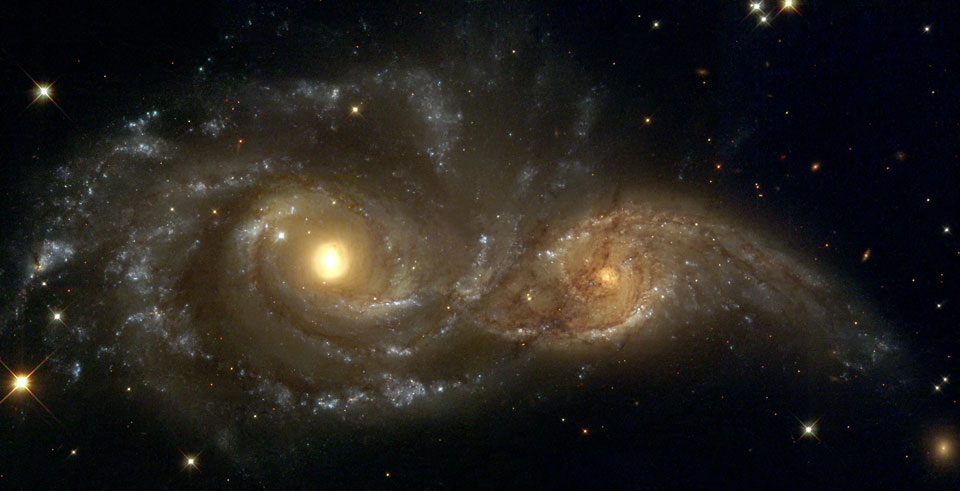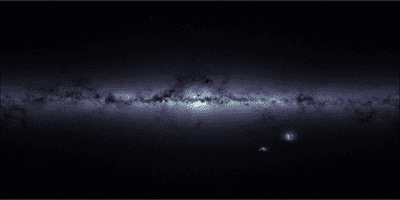Over twenty years ago astronomers first observed an unusually high density of stars in the vicinity of the Virgo cluster with the Milky Way, but until now the cause of the so-called Virgo Overdensity was unknown. New research suggests that this overdensity was actually caused by a dwarf galaxy plugging into the heart of the Milky Way over 3 billion years ago. But unlike in folklore when a wooden stake plunges through the heart of a vampire, it was this cosmic impaler that was destroyed by the interaction.
The gravitational influence of the Milky Way ripped the dwarf galaxy apart leaving behind telltale shell-like formations of stars as the only evidence of the violent collision. Evidence that has now been uncovered by astronomers.

“When we put it together, it was an ‘aha’ moment. This group of stars had a whole bunch of different velocities, which was very strange,” says Heidi Jo Newberg, the Rensselaer Institute professor of physics, applied physics, and astronomy, who led the team that made the discovery. “Now that we see their motion as a whole, we understand why the velocities are different, and why they are moving the way that they are.”
The team’s research is published in the latest edition of The Astrophysical Journal. They detail two shell-like structures in the Virgo Overdensity and a further pair in Hercules Aquila Cloud region. Their findings are based on data provided by the Sloan Digital Sky Survey, the European Space Agency’s Gaia space telescope, and the LAMOST telescope in China.
The Virgo Overdensity: Evidence of a Cosmic Collision
The Virgo Overdensity has, until now, been something of an oddity amongst such clusters. Star surveys have revealed that some of the stars that make up the Virgo Overdensity are moving toward us, whilst others are moving away. This is behaviour that would not normally be seen in a cluster of this kind. In 2019, researchers from the Rensselaer Institute had put forward the idea that this is because the overdensity is a result of a radial — or T-bone — collision.
The shell structures described in this new study — not observed before–seems to confirm this origin for the Virgo Overdensity. These arcs of stars — curved like umbrellas — are believed by the team to be the what remains of the dwarf galaxy after it was pulled apart by the Milky Way’s overpowering gravitational influence.
The process caused the dwarf galaxy to ‘bounce’ through the centre of the Milky Way with its stars being gradually incorporated into our galaxy. Each time the dwarf galaxy passed through the Milky Way’s centre the stars would initially move quickly, gradually being slowed by the gravity of our galaxy, until this influence eventually pulls them back. Each time the dwarf galaxy ‘threaded back’ through the centre a new shell was created.
Counting the number of shells allowed the team to calculate how many cycles the dwarf galaxy has undergone which in turn allows them to estimate how many years it has been since the collision — which they are naming the ‘Virgo Radial Merger’ — took place. Thus the team dates the first passage of the dwarf galaxy through the centre of the Milky Way at 2.7 billion years ago.
The Immigrant’s Song
Lead author Newberg believes that the majority of the stars in the Milky Way’s halo — a spherical cloud of stellar bodies that surround our galaxy’s spiral arms — appear to be ‘immigrants’ that formed in smaller galaxies and deposited by collisions different from the radial merger described above.
The researcher, who specialises in the Milky Way’s stellar halo, says that as dwarf galaxies were absorbed into the Milky Way, ensuing tidal forces pulled their stars into long cords moving in unison through the halo. These are so-called tidal mergers which are both less violent and far more common than radial collisions.
The fact that radial mergers are uncommon means the team was slightly taken back by the discovery of such evidence in the centre of the Milky Way. It was only as the team began to model the movement of the Virgo Overdensity that the significance of their discovery began to dawn on them.

“There are other galaxies, typically more spherical galaxies, that have a very pronounced shell structure, so you know that these things happen, but we’ve looked in the Milky Way and hadn’t seen really obvious gigantic shells,” explains Thomas Donlon II, a Rensselaer graduate student and first author of the paper. “And then we realized that it’s the same type of merger that causes these big shells. It just looks different because, for one thing, we’re inside the Milky Way, so we have a different perspective, and also this is a disk galaxy and we don’t have as many examples of shell structures in disk galaxies.”
In addition to pointing towards the radial collision almost 3 billion years ago, the team’s research has potential implications for other stellar phenomena. In particular, the findings indicate that the ‘Gaia Sausage’ — a formation that astronomers believe is the result of a collision with a dwarf galaxy between 8 and 11 billion years ago — was not created by the same event that created the Virgo Overdesity, as scientists had previously believed.
The team’s findings clearly imply that the Virgo Overdensity is much younger than the Gaia Sausage meaning that the two had different origins, or that the colourfully named ‘sausage’ is fresher than previously believed. This would also mean that it could not have caused the thick central disc stars at the centre of the Milky Way.
“There are lots of potential tie-ins to this finding,” concludes Newberg. “The Virgo Radial Merger opens the door to a greater understanding of other phenomena that we see and don’t fully understand, and that could very well have been affected by something having fallen right through the middle of the galaxy less than 3 billion years ago.”


